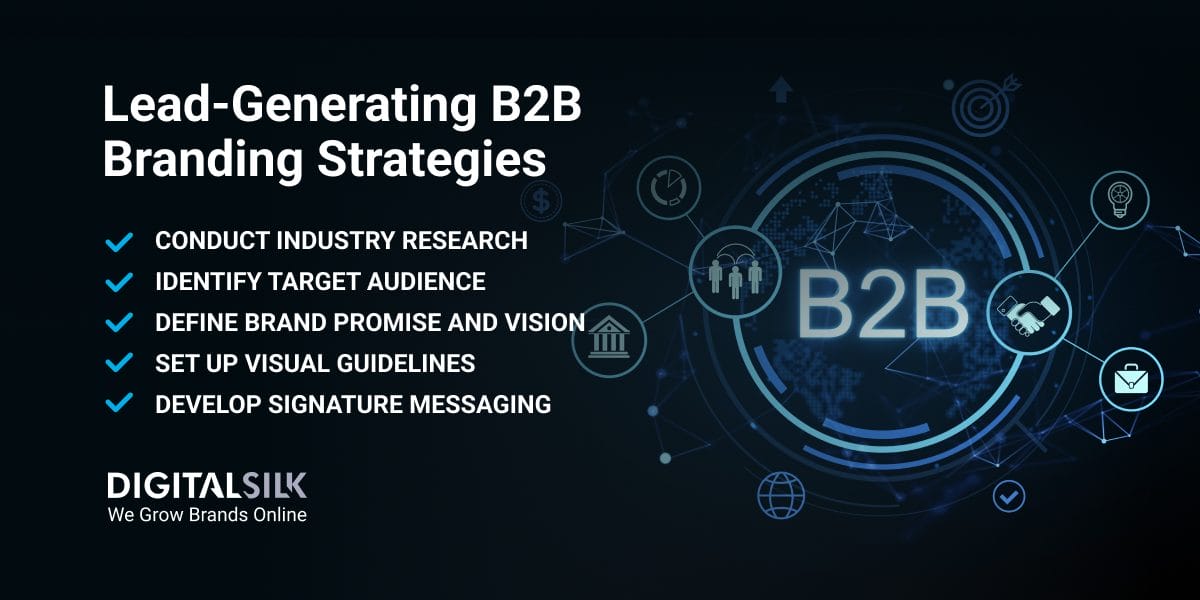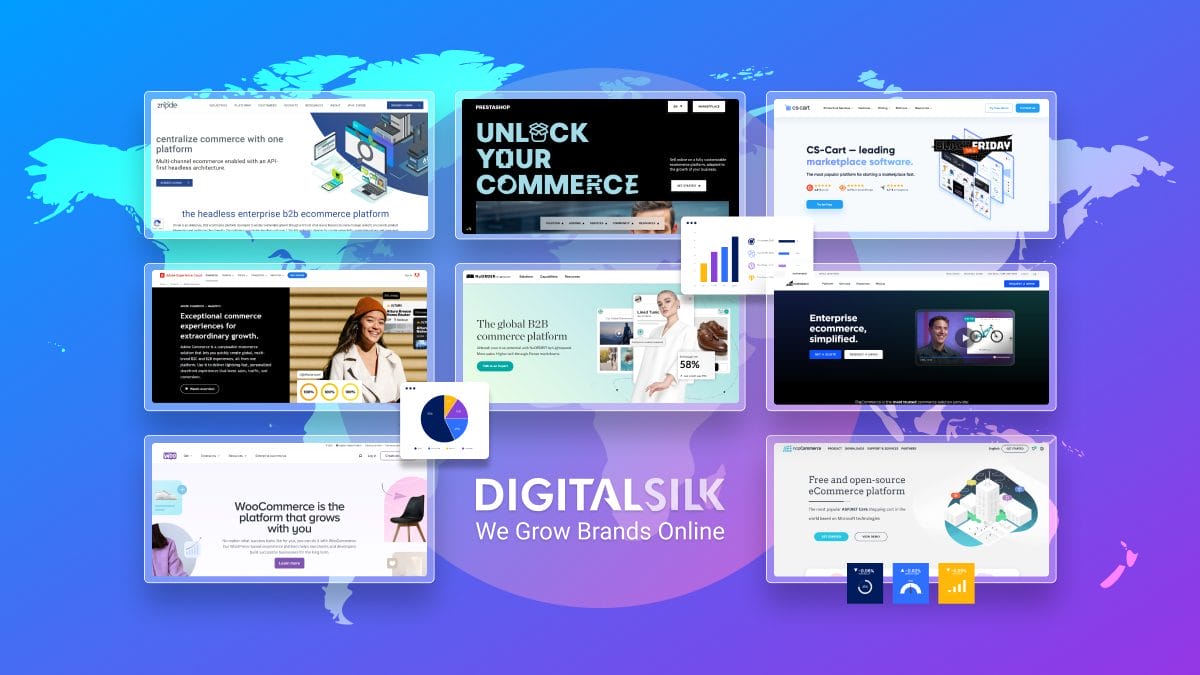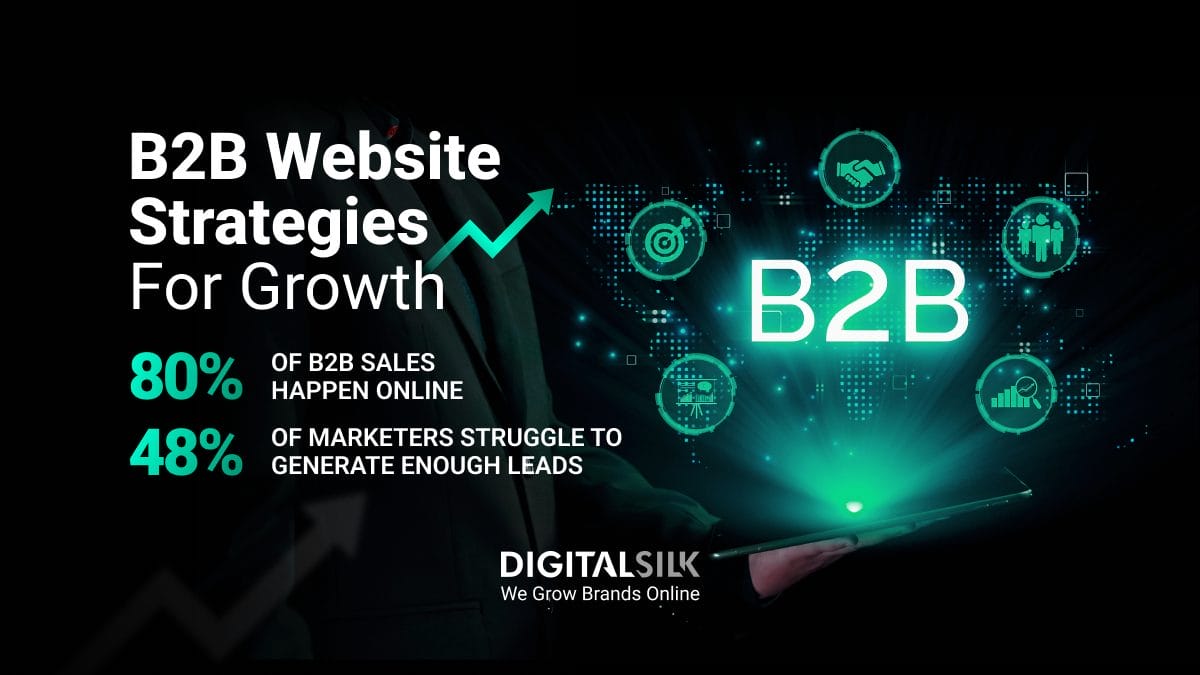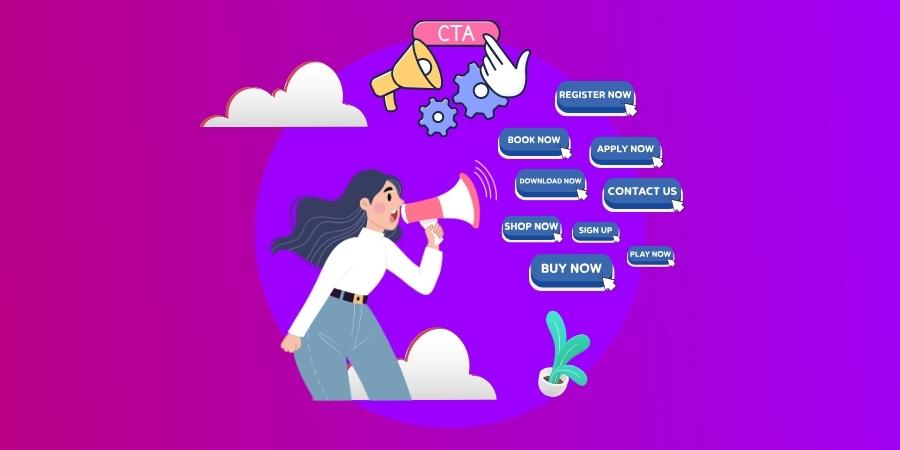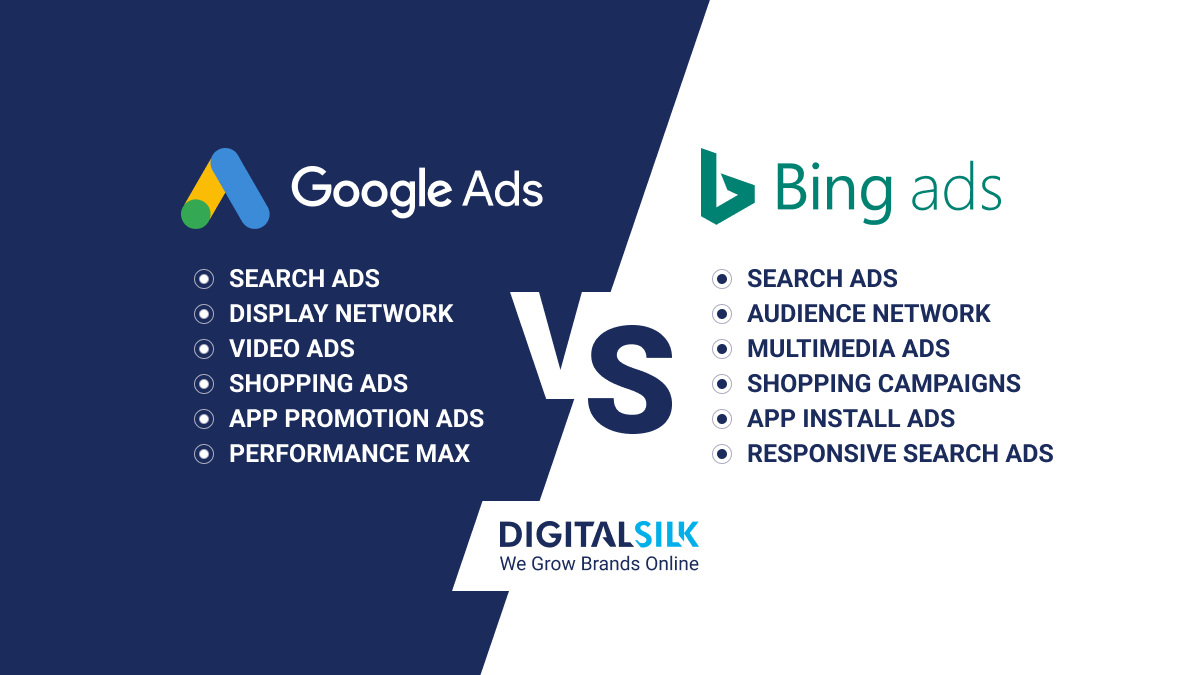B2B Branding: Key Highlights
-
Data & research define brand identity: Thorough competitor analysis and buyer insights shape distinct positioning.
-
Consistent brand experiences build trust: Cohesive visuals, messaging and UX foster recognition and confidence across touchpoints.
-
Thought leadership & multi-channel engagement fuel growth: Value-driven content and brand communities nurture leads and drive ROI.
How can you increase brand preference in a market where 69% of B2B businesses are struggling to sustain sales momentum?
In an industry that prioritizes ROI and measurable results, creating a signature brand identity can shift the narrative and turn B2B obstacles into growth opportunities.
Creating a signature branding strategy requires a structured approach grounded in research, consistency and customer-centric practices.
In this guide, we’ll list 10 B2B branding strategy steps to creating a recognizable identity, highlight their importance in supporting business growth and discuss common challenges regarding implementation.
Step-By-Step: How To Build A B2B Brand
69% of B2B businesses plan to increase spending on lead generation over the next 12 months, which can only amplify the competition in an already crowded market.
A signature branding strategy can help you attract the right audience, guide your business efforts and minimize unnecessary spending on unqualified leads.
Below, we’ve outlined the signature steps to building a branding strategy for B2B companies, along with actionable tips and relevant examples to help you get started.
Step 1. Conduct Industry And Competitive Research
Before you define who you are as a brand, you need to understand the industry and competitors in your chosen niche.
You can gain valuable insights into the major players in the field and market insights by:
- Analyzing industry reports for data on recent trends and customer needs
- Monitoring competitor activities and strategies to identify opportunities and threats
- Using social media listening tools to gather customer feedback and sentiments
- Attending industry events and conferences to gain industry knowledge
This research forms the foundation of your B2B branding strategy and helps you define a distinct and ownable market position.
The goal isn’t just copying what the competition does, but spotting patterns, uncovering opportunities and finding gaps in the market that your brand can fill.
This strategy empowers you to outthink the competition by solving problems they might be overlooking and providing unique value to your target audience.
Step 2. Identify Target Audience And Buyer Personas
82% of businesses say high-quality audience data helps them create a successful branding strategy.
B2B clients differ from B2C audiences because they usually require long-term solutions to business problems, have more complex decision-making processes and are more focused on specific needs rather than emotional appeal.
Creating actionable buyer personas and target audience profiles usually involves:
- Pinpointing your target clients’ industries, company sizes, roles and responsibilities
- Considering their pain points, goals and challenges along the user journey
- Identifying buying behaviors and preferences, such as preferred channels and communication styles
- Researching their decision-makers, processes and influencers
- Understanding their budget limitations and potential deal breakers
- Offering brand value equations and differentiators
You can combine these insights with quantitative metrics regarding demographics from platforms like Google Analytics or Search Console to determine key audience segments and tailor your messaging accordingly.
For instance, Slack targets professionals and teams looking for a more efficient communication tool.
The platform clearly outlines its core features, such as real-time messaging, file sharing and third-party integrations to speak directly to its clients’ needs and pain points.
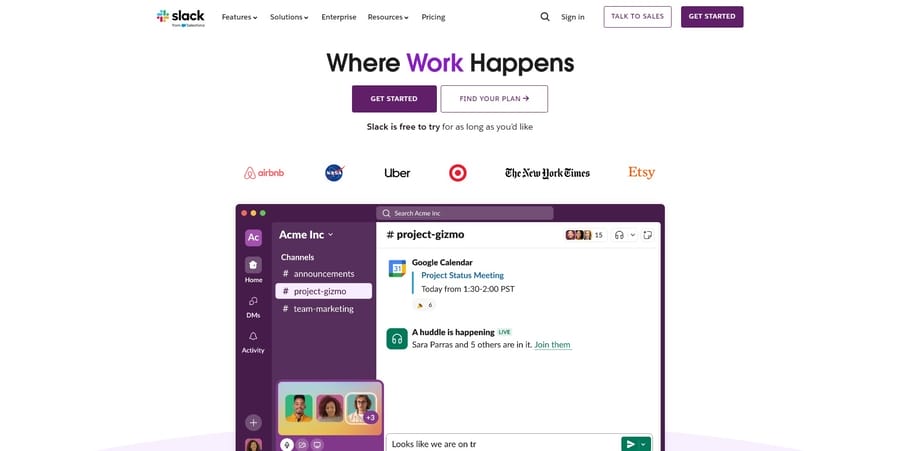
Step 3. Define Brand Promise, Mission And Vision
Your brand promise, mission and vision are the heart and soul of your B2B branding strategy — the promise you make, the mission you pursue and the vision you carry into the future.
These elements give your audience tangible reasons to connect with your brand, engage with your products and services and ultimately become loyal customers.
Your brand promise should set clear expectations for what your customers can expect from you.
Prioritize authentic and attainable promises that align with your company’s values and capabilities.
Your mission statement should outline the purpose of your business, why you exist and the steps you take to live up to your promises, while your vision determines the guidelines and direction for your company’s future.
For example, Zendesk clearly states its “customizable and scalable” software solutions that improve customer support, boost employee productivity and provide analytical insights.
Step 4. Set Up Visual Guidelines
55% of your brand’s first impressions are visual.
This means users are more likely to remember your visual brand language, such as colors and fonts, before any words or messages.
A comprehensive B2B brand book helps you maintain consistency and reinforces your identity across all marketing efforts and business interactions.
This strategy showcases signature visual elements and explains the reasoning behind them in a way that team members and partners can easily follow.
Some of the elements you can elaborate on in your brand book include:
- Brand overview: Clearly define what your brand stands for, including your mission, vision and values to guide all business decisions and communications.
- Logo use: Explain its design, what it symbolizes and how it should be used consistently across all platforms, touchpoints and collaterals. This helps you establish a trustworthy and recognizable brand image.
- Color Palette: Using a specific set of colors sends a consistent emotional message, which shapes how people feel about your brand and influences their decision-making.
- Typography: Consistent typography ensures the brand is perceived as reliable and approachable. List the primary fonts, alternative choices and usage examples for headings, body text and captions.
- Imagery guidelines: Sticking to a certain style or type of imagery helps reinforce your brand identity and creates a more engaging experience.
- Application examples: Showing how to use the branding correctly — such as on business cards or websites — helps all parties stay unified, strengthens the brand identity and avoids improper use.
For instance, Deloitte’s signature green and black colors are consistently used across all its branding materials, website and social media accounts.
This consistency creates a memorable identity and helps audiences recognize the brand more easily.
Step 5. Develop Compelling Brand Messaging
68% of audiences cite brand stories as a deciding factor in their purchasing decisions.
For B2B businesses, this involves creating a clear and engaging voice that tells your brand’s unique story and stays consistent across every channel — from your website and social media to presentations and customer support.
When you work on your brand messaging, start by defining what your company stands for and how that translates into a narrative.
Ask yourself the following questions:
- What is the real-life story behind your company?
- What values drive your team?
- How does this translate into your product or service?
- What benefits does your product or service provide to customers?
- How do you want your customers to feel when they interact with your brand?
Create a messaging matrix that defines key communication strategies for each persona and stage.
Include elevator pitches, headlines, taglines, product benefits and proof points to connect the dots between your solution and your audience’s problems.
Stories humanize your business and let you personally connect with decision-makers, who may be getting tired of generic pitches.
For example, Capgemini’s messaging speaks to innovation with a human touch.
The brand clearly articulates the benefits of technology adoption, often supported by success stories from its global client base.
Step 6. Build And Engage Brand Communities
Building and engaging brand communities focuses on creating spaces where your clients and partners feel heard and connected.
It means going beyond traditional marketing to create fertile ground for real conversation, shared values and mutual support.
Rather than simply delivering messages, you invite your audience into an ongoing dialogue that builds trust and drives collaboration.
Start by identifying the platforms your audience uses — such as a dedicated forum, a LinkedIn group or regular webinars — and design an approach that focuses on genuine interaction.
Encourage members to share their experiences and challenges and host events or discussions that invite feedback.
For example, Notion has a dedicated community section on its website that consists of passionate and creative individuals who host events, make videos, lead discussions and share tips on using the platform.
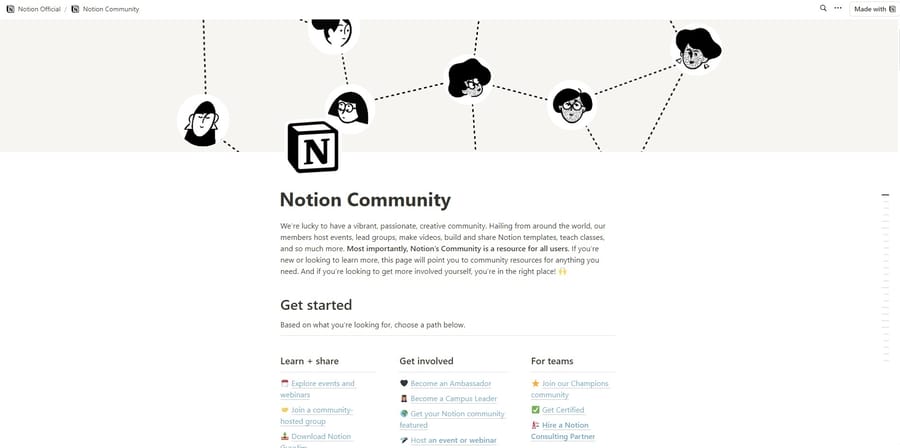
Step 7. Highlight Client Testimonials And Case Studies
76% of B2B customers would choose another supplier if they can’t find customer reviews.
Testimonials and case studies provide real stories that explain the challenges clients faced, the approach your team took and the measurable results that followed.
This approach establishes your authenticity and offers prospects a glimpse into the potential value your services or products can bring.
You can highlight testimonials and case studies in business to business branding by:
- Asking thoughtful questions: Ask clients open-ended questions that prompt them to describe their journey and reveal the nuances behind their challenges and successes.
- Incorporating data: Use specific numbers or percentages to illustrate improvements or achievements made through your product or service.
- Using multiple formats: Offer your audience options to read, watch or listen to these stories. Video testimonials increase the time users spend on your website by a significant 88%.
- Prioritizing readability: Present case studies with clear sections that outline the challenge, the approach and the results. An organized layout helps busy professionals quickly grasp the core message.
- Including direct quotes: Use real quotes from clients to build credibility and showcase the positive impact of your offerings.
Salesforce ticks all of these boxes with its customer success stories and dedicated YouTube testimonials that feature satisfied clients, tangible results and enthusiastic sentiments.
Step 8. Use Thought Leadership And Content Marketing
You can establish your brand as an industry authority by creating valuable content and sharing it through leadership channels.
This includes publishing whitepapers, research reports, blogs, videos, webinars and podcasts that educate, inform and engage your target market.
This tactic helps audiences see your company as a reliable source of information and industry trends, which builds trust and credibility.
With 73% of B2B brands using content marketing to optimize user journeys and boost sales, you can implement the following strategies to beat them to the punch:
- Publish Detailed Analyses: Develop in-depth articles or reports that break down complex topics into digestible parts.
- Use multiple formats: Experiment with podcasts, webinars and videos alongside written articles to reach a wider audience.
- Engage with your community: Participate in industry discussions, answer questions and invite guest contributions.
- Keep your content current: Regular content updates keep your insights relevant and demonstrate your commitment to ongoing learning.
For instance, Digital Silk publishes our annual Digital Trends Guide on the latest insights and strategies for web design, branding and digital marketing.
Step 9. Prioritize Multi-Channel Engagement
Using multi-channel engagement means connecting with your audience on several platforms so your message can reach a wider audience and stay top-of-mind.
The average B2B buyer examines 13 pieces of content throughout their purchasing journey.
When your messaging aligns across these touchpoints, your visibility increases and trust naturally follows.
Start by mapping out where your audience spends the most time — this might be LinkedIn for professional content, Twitter for quick updates or webinars and podcasts for in-depth discussions.
Once you determine key channels, follow these B2B branding strategy steps:
- Craft consistent narratives: Keep your tone and core message the same but adjust the presentation style to fit the channel.
- Plan a content calendar: Organize your posts, articles, videos and emails so that each touchpoint builds on the previous one to guide your audience toward conversion.
- Monitor Interaction: Track metrics across channels to learn which platforms spark conversations and conversions.
- Encourage cross-platform sharing: Include calls-to-action that invite your audience to follow you on other channels, deepening their connection to your brand.
- Test and refine: Experiment with different formats and posting schedules, listen to feedback and adjust your strategy accordingly.
Take SAP as an example — the brand combines written guides, video tutorials and live Q&A sessions to address enterprise software solutions.
Step 10. Integrate Brand Guidelines Into UX Design
With 80% of B2B sales expected to take place online in 2025, your branding strategy doesn’t stop at core messaging, tone and visuals.
You should implement these guidelines into your website, apps and other digital platforms so they feel like a natural extension of your brand and boost recognition.
Some tips to keep in mind when integrating brand guidelines into your User Experience (UX) design are:
- Analyze brand guidelines: Review core elements such as color palette, fonts, imagery and tone and collaborate with UX designers to translate these elements into interactive components.
- Create a Design System: Develop a library of UI components — buttons, forms or icons — that reflect your style guide.
- Test with real users: Conduct usability tests to see if the design resonates with your audience use the feedback to adjust visual elements or interactions.
- Document the Process: Keep a living document that details how brand elements should appear in digital products to maintain consistency as your platform evolves.
For example, Aramark is a food service and facilities management company that integrates core brand elements into its website to establish its signature identity and drive brand recognition.
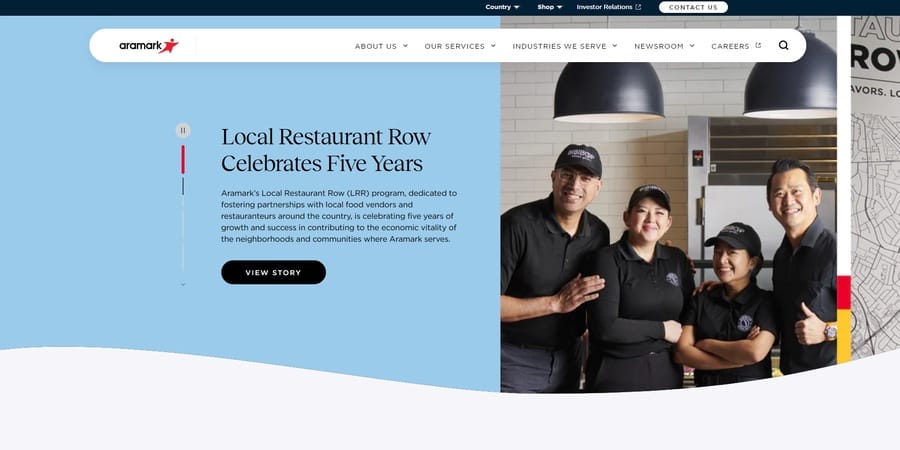
Digital Silk’s B2B Branding Strategy Example

Digital Silk partnered with AGS Devices to modernize its identity while preserving the legacy and trust the brand has built over the years.
The challenge was striking the right balance — refreshing its identity without losing the essence of what made AGS Devices a trusted name in high-quality, reliable components.
Our brand strategy focused on reinforcing its core value — delivering components on time and on budget.
Our team refined AGS Devices’ messaging to clearly communicate its expertise, reliability and commitment to quality to help the brand stand out in the competitive B2B space.
Moreover, Digital Silk modified its existing logo rather than completely redesigning it, maintaining a visual connection to its history while giving it a more modern, streamlined look.
This approach kept the familiarity intact for long-time customers while signaling growth and innovation.
The Importance Of Data-Driven Brand Strategies
Some of the key benefits of using data-driven brand strategies include:
- Enhanced brand visibility: You can use actionable audience insights on demographics and psychographics to identify pain points, preferences, and purchase behaviors so you can tailor your brand message to better resonate with your target market.
- Increased audience reach: 66% of U.S. B2B shoppers use Internet search results to find new products. Data reveals which channels and messages convert the most prospects into customers and reach a wider audience more effectively.
- Improved customer loyalty: Tracking customer interactions helps pinpoint areas to personalize experiences and nurture long-term relationships. Happy customers often become brand advocates who drive organic growth through positive word-of-mouth.
- Support for market differentiation: Knowing how customers interact with your brand can help develop unique selling propositions and competitive advantages. Use data to inform product development, messaging and positioning strategies.
Common Challenges In Creating B2B Branding Strategies
Creating an effective B2B branding strategy means tackling some well-known challenges head-on. Some of the key obstacles include:
- Supervising longer sales cycles: Focus on building trust over time with consistent, informative content that guides prospects along a long decision-making process. Nurturing leads through targeted content can shorten the sales cycle by keeping the conversation alive.
- Managing multiple decision-makers: B2B purchases often involve several stakeholders with unique priorities. Tailor your messaging to address different concerns and create materials that speak to each role within the buying group.
- Balancing industry expertise with promotional content: Support in-depth industry knowledge with subtle promotional cues, so your content feels valuable rather than sales-driven.
- Maintaining global appeal with localized relevance: Create a brand narrative that resonates on an international scale while adapting key elements to fit local cultures and market needs.
Key Metrics For Your B2B Branding Strategy
Creating a successful B2B branding strategy is just the beginning — the real challenge lies in measuring its impact on your revenue, reputation and long-term growth.
C-level executives often rely on specific metrics to assess ROI and optimize branding efforts. Here are some effective ways to gauge your branding success:
- Brand equity and awareness surveys: Regularly conduct surveys, both internally and externally, to understand how well your branding resonates with your stakeholders. Your team’s insights and your audience’s feedback can reveal a lot about your brand’s perception.
- Net Promoter Score (NPS): This simple but powerful tool helps you track how likely your clients are to recommend your brand to others. It’s a clear indicator of your brand’s health and customer loyalty.
- Customer Acquisition Cost (CAC) and Lifetime Value (LTV): Monitor these metrics closely to see how improvements in branding can lower your customer acquisition costs while boosting long-term loyalty. A well-recognized brand often attracts clients more cost-effectively.
- Social listening and sentiment analysis: Pay attention to conversations happening about your brand across social media and other platforms. Understanding how prospects and existing clients perceive your brand is crucial for maintaining and improving your reputation.
- Lead quality and conversion rates: Analyze whether your new branding strategy is drawing in higher-quality leads that convert more quickly. This insight will help you refine your approach and focus on what truly works.
Monitoring these metrics not only helps you validate the resources you invest in branding but also provides valuable insights for shaping your future strategy.
Over time, a well-assessed branding approach will demonstrate tangible returns to your leadership team, ensuring continued support for your branding initiatives.
Develop An Effective B2B Branding Strategy With Digital Silk
The B2B industry requires a shift toward more thoughtful and relationship-driven branding strategies for long-term ROI over short-term gains.
Digital Silk‘s expert branding and digital strategies monitor the latest best practices and industry insights to create tailored, scalable and effective B2B branding strategies.
As a recognized web design agency, we offer the following services:
- Branding services
- Brand identity
- Logo and brand design
- Custom web design
- Custom web development
Our team takes a proactive and consultative approach for each project, offers complete transparency throughout its lifecycle and delivers measurable results.
Contact our team, call us at (800) 206-9413 or fill in the Request a Quote form below to schedule a consultation.
"*" indicates required fields


